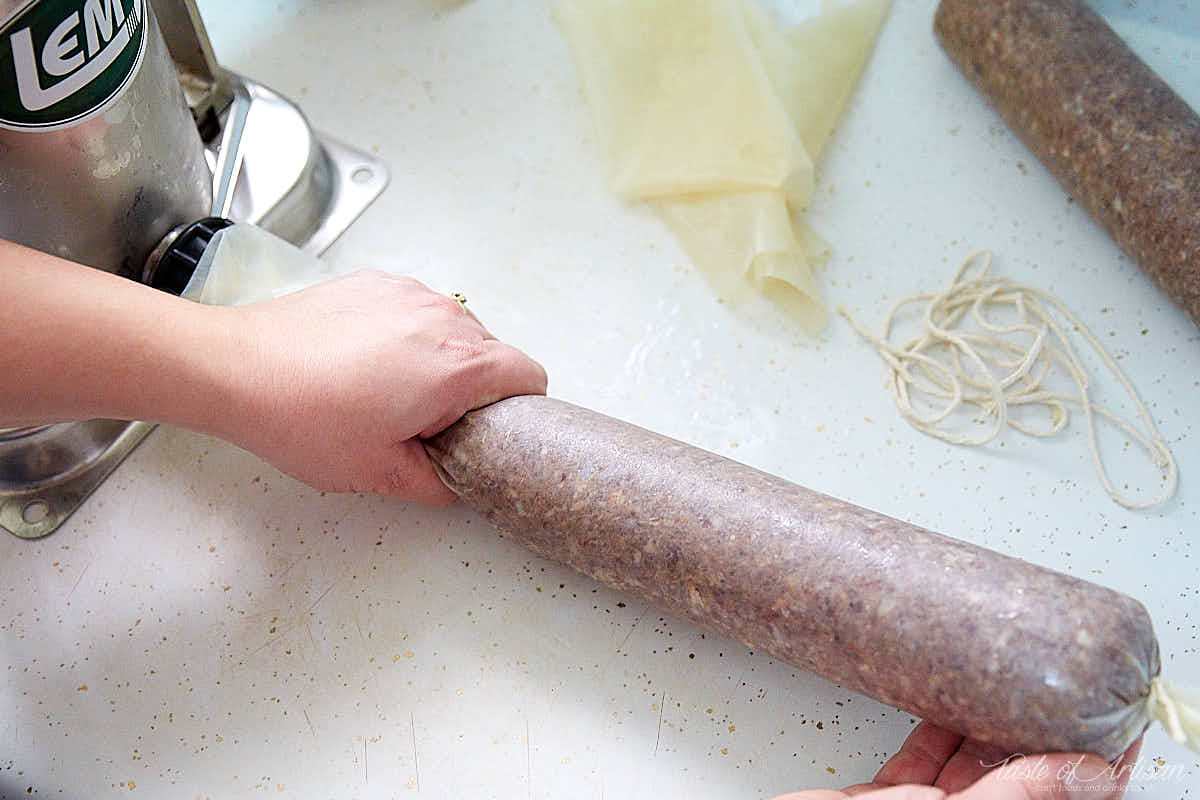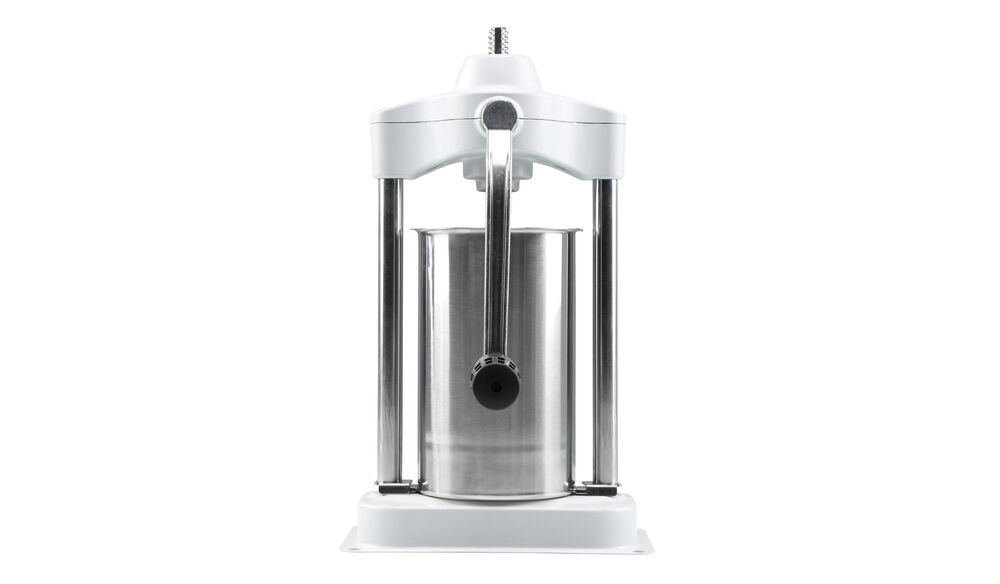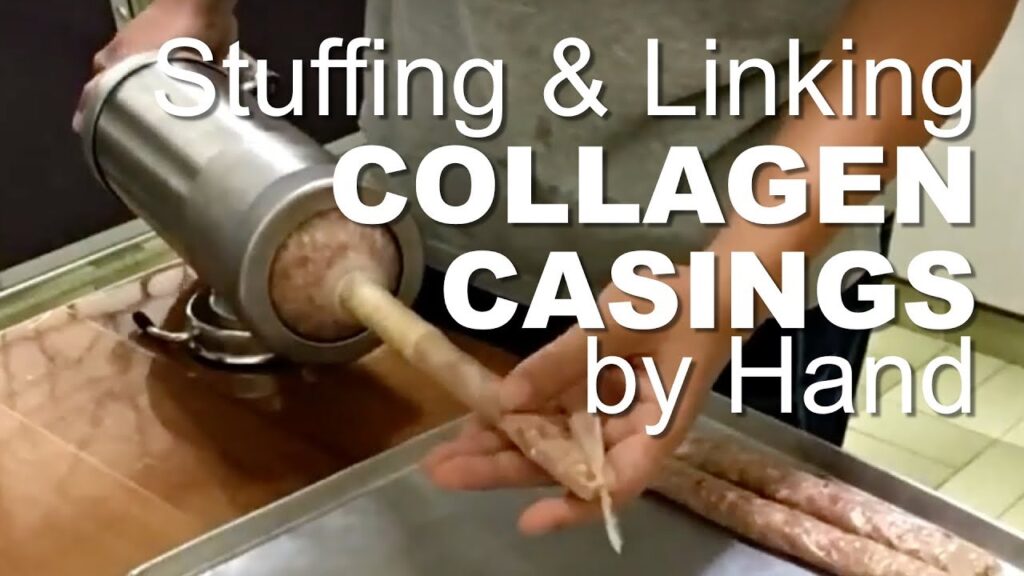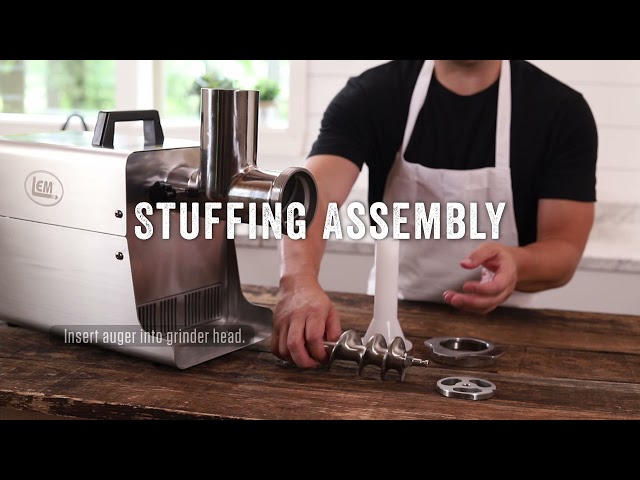To stuff summer sausage casings, press the meat into a sausage stuffer, attach the fibrous casing, and crank the stuffer to fill the casing tightly without overfilling it. Soaking the casing in hot water with a little vinegar added for at least an hour before stuffing can help prevent sticking.
Additionally, choosing the correct stuffing tube and avoiding blowouts and backflow are important considerations. Whether making summer sausage for the first time or looking to improve your technique, there are many resources available online for guidance and tips. From videos on YouTube to instructional blog posts, it’s easy to find the information you need to make delicious summer sausage at home.
Introduction To Summer Sausage Stuffing
To stuff summer sausage casings, first press the meat into a sausage stuffer, ensuring to push out any air pockets. Attach the casing to the sausage stuffer nozzle and fill it tightly but not too much. Follow instructions for processing and closing the casings, and enjoy your final product.
Soak the casings in hot water with vinegar before starting.
Summer sausage stuffing is a time-honored tradition that brings together the essential elements of meat, spices, and casings to create a flavorful and satisfying delicacy. Whether you are a seasoned sausage aficionado or a novice in the world of charcuterie, mastering the art of stuffing summer sausage casings is a fulfilling experience that yields delicious results.
Essentials For Stuffing Sausage
When it comes to stuffing sausage, having the right tools and ingredients is essential. Here are the key essentials you’ll need:
- Sausage stuffer or funnel
- Fibrous or collagen casings
- High-quality ground meat and seasonings
- Knife or scissors for trimming casings
History And Popularity Of Summer Sausage
Summer sausage has a rich history dating back to European traditions, where it was created as a method of preserving meat during the warmer months. Over time, it has become a beloved staple in charcuterie boards, picnics, and holiday gatherings, gaining popularity for its robust flavor and versatility in culinary applications.
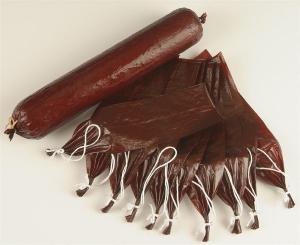
Credit: www.butcher-packer.com
Selecting The Right Casings
When it comes to making summer sausage, selecting the right casings is crucial for achieving the perfect texture and flavor. There are various types of sausage casings to choose from, and each type offers unique characteristics that can influence the final product.
Types Of Sausage Casings
There are three main types of sausage casings: natural, collagen, and fibrous. Natural casings, typically made from animal intestines, are known for their traditional appeal and distinct snap when bitten into. Collagen casings, made from the collagen in animal hides, are uniform in size and provide consistent results. Fibrous casings, crafted from cellulose, are ideal for smoking and can be easily peeled off after cooking.
Preparing Casings For Stuffing
Before stuffing the casings, it’s essential to prepare them properly. If you’re using natural casings, ensure they are thoroughly rinsed and soaked in water to remove any salt and odor. Collagen and fibrous casings generally do not require soaking, but it’s essential to follow the manufacturer’s instructions to ensure optimal results.
Gathering Your Equipment
Before you embark on the delicious journey of stuffing summer sausage casings, it’s important to gather all the necessary equipment. Having the right tools will ensure a smooth and successful sausage-making process. Here are some essential items you’ll need:
Choosing A Sausage Stuffer
One of the most important pieces of equipment for stuffing sausage casings is a sausage stuffer. There are various types available, including manual and electric options. When choosing a sausage stuffer, consider the following:
- Capacity: Depending on the quantity of sausage you plan to make, select a stuffer with an appropriate capacity.
- Construction: Look for a stuffer made of durable materials like stainless steel, as it will last longer and be easier to clean.
- Features: Some stuffers come with different-sized nozzles or attachments, allowing you to create sausages of varying thicknesses.
Stuffing Tubes And Their Uses
Stuffing tubes are attachments that connect to the sausage stuffer and guide the meat mixture into the casings. Different sizes of stuffing tubes are available to accommodate various casings and sausage types. Here are the common types of stuffing tubes:
| Tube Size | Use |
|---|---|
| Large | Perfect for larger casings like summer sausage casings |
| Medium | Ideal for medium-sized casings such as bratwurst or Italian sausage casings |
| Small | Used for smaller casings like breakfast sausage casings |
Make sure to choose the appropriate stuffing tube size based on the type of casing you will be using. Using the correct tube size will ensure the sausage mixture is properly filled into the casings.
Now that you have gathered your equipment, you are ready to move on to the next steps of stuffing summer sausage casings. Stay tuned for our upcoming blog post on preparing the sausage mixture and the actual stuffing process.

Credit: m.youtube.com
Mixing Your Sausage Meat
To stuff summer sausage casings, press the sausage meat into the sausage stuffer firmly to remove any air pockets. Then, attach the fibrous casing to the nozzle of the stuffer and crank the stuffer to fill the casing. Stuff the casings tightly, but avoid overfilling them.
Ingredients For The Perfect Mix
To achieve the perfect mix for your summer sausage, you’ll need a few key ingredients. Here’s what you’ll need to gather before you start:- High-quality meat: Choose a fatty cut of meat, such as pork shoulder or beef chuck, as the fat will help keep the sausage moist and flavorful.
- Seasonings: This is where you can get creative and add your own personal touch. Common seasonings for summer sausage include garlic powder, black pepper, mustard seeds, and paprika.
- Cure: Adding a cure is essential for food safety and to give your sausage that characteristic pink color. Prague Powder #1 or Insta Cure #1 are commonly used cures for summer sausage.
- Liquid: This could be water, wine, or even beer. The liquid helps to distribute the seasonings evenly throughout the meat.
Avoiding Common Mixing Mistakes
Mixing your sausage meat correctly is crucial for achieving the desired texture and flavor. Here are some common mistakes to avoid:- Overmixing: Be careful not to overmix the meat, as this can result in a tough texture. Mix just until the ingredients are evenly distributed.
- Undermixing: On the other hand, undermixing can lead to uneven distribution of seasonings and cure. Make sure to mix thoroughly to ensure a consistent flavor throughout.
- Incorrect temperature: It’s important to keep the meat and other ingredients cold during the mixing process. This helps prevent the fat from melting and ensures a better texture in the final product.
- Not using enough liquid: The liquid helps bind the ingredients together and distribute the seasonings. Make sure to add enough liquid to achieve a moist and well-seasoned sausage.
Stuffing The Casings
To stuff summer sausage casings, press the meat into a sausage stuffer, ensuring to eliminate any air pockets. Attach the fibrous casing to the stuffer nozzle and fill the casing by cranking the stuffer. It’s important to stuff the casings tightly without overfilling.
Filling The Casings Evenly
To fill summer sausage casings evenly, it’s important to press the meat into your sausage stuffer with enough force to eliminate any air pockets. This ensures that the sausage will not burst during cooking. Once the meat is in the stuffer, attach the fibrous casing to the nozzle and crank the stuffer to fill the casing. Make sure to stuff the casings tightly but avoid overfilling them, as this can cause the sausage to burst.Preventing Air Pockets
To prevent air pockets in your summer sausage, it’s important to press the meat firmly into the sausage stuffer. You can also use a skewer or needle to puncture any air pockets that may have formed during the stuffing process. Another helpful tip is to twist the sausage into links as you stuff the casing, which can help to eliminate any air pockets and ensure even cooking.Final Thoughts
Stuffing summer sausage casings may seem like a daunting task, but with the right tools and techniques, it can be a fun and rewarding experience. Whether you’re a seasoned sausage maker or a beginner, the key to success is to take your time, be patient, and follow the steps carefully. With a little practice, you’ll be stuffing casings like a pro in no time!Closing And Tying Off Casings
To stuff summer sausage casings, press the meat into a sausage stuffer, ensuring there are no air pockets. Attach the casings to the stuffer nozzle and fill the casing by cranking the stuffer. Make sure to stuff the casings tightly but avoid overfilling.
Closing and Tying Off Casings is the final step in the process of stuffing summer sausage casings. It is crucial to ensure that the ends of the casings are sealed properly to prevent the meat from spilling out during cooking. Techniques for Sealing Sausage Ends and Tips for a Professional Finish are essential to achieve a perfect summer sausage. Techniques for Sealing Sausage Ends: 1. Twist and Pinch: Twist the casing, then pinch and twist it again to create a tight seal. Cut off any excess casing with scissors. 2. Loop and Tie: Make a loop at the end of the casing and tie it with a butcher’s knot. Repeat the process on the other end of the casing. 3. Slip Knot: Create a slip knot by forming a loop at the end of the casing and pulling it through itself. Tighten the knot by pulling both ends of the loop. Tips for a Professional Finish: 1. Use a Butcher’s Twine: Tie off the casing with a butcher’s twine to give it a professional look. 2. Chill the Sausage: Chill the sausage in the refrigerator for at least an hour before tying it off. This will help the sausage retain its shape and prevent it from bursting. 3. Don’t Overstuff: Overstuffing the casing can cause it to burst during cooking. Stuff the casing tightly but leave some room for the sausage to expand. In conclusion, mastering the art of Closing and Tying Off Casings is essential to make a perfect summer sausage. Using the right techniques and following these tips can help you achieve a professional finish. So, go ahead and try these techniques to make a delicious summer sausage at home.Cooking Your Summer Sausage
To stuff summer sausage casings, press the meat into your sausage stuffer, ensuring to eliminate air pockets. Attach the fibrous casing to the stuffer nozzle and crank it to fill the casing tightly but not overfill. This method ensures the sausage is evenly and securely stuffed for a delicious outcome.
Cooking Methods And Temperatures
When it comes to cooking your summer sausage, there are a few different methods and temperatures you can choose from. The cooking method you use will depend on your personal preference and the equipment you have available. Here are some common cooking methods and their recommended temperatures for summer sausage:- Smoking: Smoking is a popular method for cooking summer sausage as it imparts a delicious smoky flavor. To smoke your sausage, preheat your smoker to a temperature of 180-200°F (82-93°C). Smoke the sausage for 3-4 hours or until the internal temperature reaches 155-160°F (68-71°C).
- Oven Baking: If you don’t have a smoker, you can also bake your summer sausage in the oven. Preheat your oven to 300°F (149°C). Place the sausage on a baking sheet and bake for 1-2 hours or until the internal temperature reaches 155-160°F (68-71°C).
- Grilling: Grilling is another option for cooking summer sausage, giving it a slightly charred and smoky flavor. Preheat your grill to medium heat (around 350°F or 177°C). Place the sausage on the grill and cook for 20-30 minutes, turning occasionally, until the internal temperature reaches 155-160°F (68-71°C).
Knowing When Sausage Is Done
It’s essential to know when your summer sausage is cooked to perfection. Here are a few tips to help you determine if your sausage is done:- Use a meat thermometer: The most accurate way to check the doneness of your sausage is by using a meat thermometer. Insert the thermometer into the center of the sausage, making sure it doesn’t touch the casing. The internal temperature should read 155-160°F (68-71°C) for fully cooked sausage.
- Check for firmness: Gently press the sausage with your finger. If it feels firm and springs back, it is likely cooked. If it feels soft or squishy, it may need more time.
- Look for clear juices: When the sausage is fully cooked, it should release clear juices when pierced with a fork or knife. If the juices are still pink or cloudy, continue cooking.
Storing And Serving
To stuff summer sausage casings, press the meat into a sausage stuffer, attach the fibrous casing, and crank the stuffer to fill the casing. Ensure the casings are stuffed tightly but not overfilled to avoid bursting. Soak the casings in hot water with a drop of vinegar for at least an hour before use to prevent sticking.
Best Practices For Storage
When it comes to storing summer sausage, it’s important to follow a few best practices to ensure its freshness and flavor are preserved. Here are some tips for storing your summer sausage properly: 1. Refrigerate: After stuffing the casings and allowing the sausage to fully cure, it is recommended to store them in the refrigerator. The cool temperature helps slow down the growth of bacteria and extends the shelf life of the sausage. 2. Vacuum Seal: To further prolong the freshness of your summer sausage, consider vacuum sealing it. This method removes air from the packaging, preventing oxidation and reducing the risk of spoilage. 3. Label and Date: To keep track of the freshness of your summer sausage, it’s a good practice to label each package with the date it was made. This way, you can easily identify the oldest sausage and consume it first. 4. Freezing: If you have a large quantity of summer sausage or want to store it for an extended period, freezing is an excellent option. Wrap the sausage tightly in plastic wrap or aluminum foil, then place it in a freezer bag or airtight container. Remember to label each package with the date as well.Creative Serving Suggestions
Summer sausage is a versatile and delicious treat that can be enjoyed in various ways. Here are some creative serving suggestions to make the most out of your summer sausage: 1. Charcuterie Board: Arrange slices of summer sausage on a charcuterie board alongside an assortment of cheeses, crackers, and fruits. This creates an impressive and flavorful spread for entertaining guests. 2. Sandwiches and Wraps: Add sliced summer sausage to your favorite sandwiches or wraps for an extra burst of flavor. Pair it with mustard, pickles, and cheese for a satisfying lunch or snack. 3. Pizza Topping: Thinly slice summer sausage and use it as a topping for homemade pizzas. The smoky and savory flavor of the sausage pairs well with a variety of pizza toppings, such as onions, peppers, and mushrooms. 4. Appetizer Skewers: Cut summer sausage into bite-sized pieces and thread them onto skewers, alternating with cheese cubes, olives, or cherry tomatoes. This creates a delightful and easy-to-eat appetizer for parties or gatherings. 5. Pasta and Salad: Incorporate sliced summer sausage into pasta dishes or salads for an added protein boost and burst of flavor. It pairs well with both creamy and tangy dressings, adding a unique twist to your favorite recipes. Remember, when serving summer sausage, always ensure it is fully cooked and safe to consume. Whether enjoyed alone or as part of a delicious recipe, summer sausage is sure to delight your taste buds and impress your guests.Troubleshooting Common Issues
When stuffing summer sausage casings, you may encounter some common issues that can affect the quality and appearance of your sausages. Understanding how to troubleshoot these issues can help you achieve the perfect summer sausage. Here are some common problems you might face and how to fix them.
Dealing With Casing Blowouts
If you experience casing blowouts while stuffing summer sausage, it can be frustrating and messy. Casing blowouts occur when the pressure inside the casing becomes too high, causing it to burst. To prevent blowouts, make sure to soak the casings thoroughly and handle them with care to avoid tears or punctures. Additionally, ensure that the sausage mixture is not overfilled, as this can create excessive pressure. If a blowout does occur, carefully remove the damaged casing and tie off the ends of the sausages to salvage the batch.
Fixing Under Or Overstuffed Sausage
When stuffing summer sausage, achieving the right level of stuffing can be tricky. Understuffed sausages can result in loose and wrinkled casings, while overstuffed sausages may burst during cooking. To fix understuffed sausages, simply add more sausage mixture to the casings, ensuring they are filled evenly and consistently. If you find that your sausages are overstuffed, gently massage the casings to redistribute the filling and release any trapped air, then carefully twist or tie off the ends to secure the sausages.

Credit: www.stoneridgemarket.com
Alternative Methods
To stuff summer sausage casings, press the meat into a sausage stuffer, ensuring no air pockets remain. Attach the fibrous casing to the nozzle and fill it tightly but not to the point of overfilling. Avoid using a machine? No problem.
Simply use a funnel to push the sausage into the casing, being careful not to overfill it.
Stuffing Without A Machine
When it comes to stuffing sausage casings without a machine, there are a few alternative methods that can be used. One method involves using a funnel to manually fill the casings with the sausage mixture. Another option is to use a sausage stuffer attachment for a stand mixer, which can also be effective for smaller batches.
For those without specialized equipment, a simple yet effective method is to use a pastry bag or a plastic zip-top bag with a corner snipped off to manually pipe the sausage mixture into the casings. This method may require a bit more patience and precision, but it can yield good results for those who don’t have access to a sausage stuffer.
Using Natural Vs Synthetic Casings
When it comes to choosing between natural and synthetic casings for stuffing summer sausages, there are a few key differences to consider. Natural casings, typically made from animal intestines, offer a traditional, authentic look and texture to the sausages. On the other hand, synthetic casings are often easier to work with and provide more consistency in size and appearance.
While natural casings may require more preparation and care, such as soaking and rinsing before use, they can impart a unique flavor and texture to the sausages. Synthetic casings, made from materials like collagen or cellulose, are often easier to work with and do not require as much preparation, making them a convenient option for home sausage making.
Safety And Sanitation
When it comes to stuffing summer sausage casings, safety and sanitation should be your top priorities. Proper handling and cleanliness are essential to prevent any contamination and ensure that the sausage is safe to consume. In this section, we will discuss two important aspects of safety and sanitation: Keeping Your Workspace Clean and Food Safety Considerations.
Keeping Your Workspace Clean
Before you start stuffing summer sausage casings, it is crucial to have a clean and organized workspace. Here are some tips to keep your workspace clean:
- Wash your hands thoroughly with soap and water before and after handling the meat.
- Ensure that all the equipment and utensils you are using are clean and sanitized.
- Use separate cutting boards and knives for raw meat and other ingredients to avoid cross-contamination.
- Regularly clean and disinfect your workspace to prevent the growth of bacteria.
- Keep your ingredients, spices, and casings properly sealed and stored to maintain their freshness.
Food Safety Considerations
When handling raw meat, it is essential to follow food safety guidelines to prevent any foodborne illnesses. Here are some food safety considerations to keep in mind:
- Make sure the meat you are using is fresh and of high quality. Avoid using meat that is past its expiration date.
- Store the meat in the refrigerator or freezer until you are ready to use it.
- Thaw frozen meat in the refrigerator or using the defrost setting on your microwave. Never thaw meat at room temperature.
- Handle the meat with clean hands and avoid touching other surfaces or ingredients while handling raw meat.
- Cook the sausage thoroughly to an internal temperature of at least 160°F (71°C) to kill any harmful bacteria.
- Refrigerate or freeze the finished sausage promptly to maintain its freshness and prevent bacterial growth.
By following these safety and sanitation practices, you can ensure that your summer sausage is not only delicious but also safe to enjoy. Remember to always prioritize cleanliness and proper food handling techniques to protect yourself and others.
Expanding Your Sausage-making Skills
Learning how to stuff summer sausage casings is just the beginning of your sausage-making journey. As you gain confidence in this fundamental skill, it’s time to explore advanced techniques and experiment with flavors and spices to take your sausage-making to the next level.
Advanced Techniques
Once you have mastered the basics of stuffing summer sausage casings, consider exploring advanced techniques to elevate your sausage-making skills. This may include experimenting with different types of casings, such as natural casings made from animal intestines or synthetic casings made from collagen or cellulose. Additionally, you can explore different methods of smoking and curing your summer sausages to achieve unique flavors and textures.
Experimenting With Flavors And Spices
Don’t be afraid to get creative with your summer sausage recipes. Experiment with a variety of flavors and spices to create unique and delicious combinations. Whether you prefer a classic blend of garlic and black pepper or want to incorporate more adventurous flavors like fennel, chili flakes, or smoked paprika, the possibilities are endless. Keep track of your experiments so you can replicate successful flavor profiles and refine your recipes over time.
Frequently Asked Questions
How To Fill Summer Sausage Casing?
To fill summer sausage casing, press the meat into a sausage stuffer to remove air pockets. Attach the fibrous casing to the stuffer nozzle and crank to fill the casing. Stuff the casings tightly but avoid overfilling.
How Do You Stuff Sausage Casings At Home?
To stuff sausage casings at home, you will need a sausage stuffer and casings. First, press the meat into the stuffer, attach the casing to the nozzle, and crank the stuffer to fill the casing. Stuff the casings tightly but avoid overfilling.
You can also stuff casings without a machine by using a funnel. Soak the casings in hot water before stuffing.
How Do You Keep Summer Sausage From Sticking To The Casing?
To keep summer sausage from sticking to the casing, make sure to soak the casing in hot water for at least an hour before stuffing it with the meat. Additionally, try adding a drop or two of vinegar to the water.
Stuff the casing tightly but avoid overfilling it. Push hard enough to remove any air pockets and ensure the meat is evenly distributed.
Conclusion
Mastering the art of stuffing summer sausage casings is a rewarding endeavor. With the right techniques and tools, you can create delicious sausages at home. Whether using a sausage stuffer or a makeshift method, the key is to ensure a tight, air-free fill.
Experiment with different flavors and enjoy the process of crafting your own savory summer sausages.
